Themed collection Molecular Logic Gates and Information Processing

Taking baby steps in molecular logic-based computation
Constructs of fluorophores, receptors, spacers, 1O2 sensitizers, enzymes and oligonucleotides play their part in advancing the field of molecular logic-based computation.
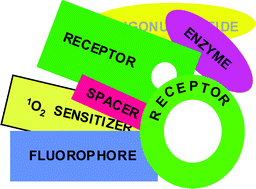
Chem. Commun., 2015,51, 8403-8409
https://doi.org/10.1039/C4CC10000J
Supramolecular electron transfer-based switching involving pyrrolic macrocycles. A new approach to sensor development?
The potential utility of energy transfer in the design of pyrrolic macrocycle-based molecular switches and ability to serve as the readout motif for molecular sensors development is discussed.
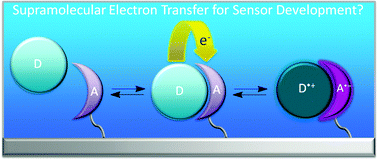
Chem. Commun., 2015,51, 7781-7794
https://doi.org/10.1039/C4CC10193F
Catalytic nucleic acids (DNAzymes) as functional units for logic gates and computing circuits: from basic principles to practical applications
Catalytic nucleic acids (DNAzymes) provide functional modules for logic gates and computing operations, and hold great promise for biomedical sensing and therapeutic applications.
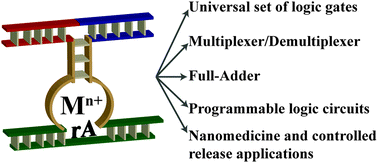
Chem. Commun., 2015,51, 4144-4160
https://doi.org/10.1039/C4CC09874A
A survey of advancements in nucleic acid-based logic gates and computing for applications in biotechnology and biomedicine
Nucleic acid based logic systems have been rationally designed and functionalized to better serve bioanalytical and biomedical applications.
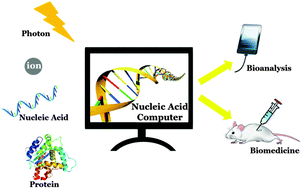
Chem. Commun., 2015,51, 3723-3734
https://doi.org/10.1039/C4CC10047F
Enzyme-based logic systems interfaced with signal-responsive materials and electrodes
Enzyme-based biocomputing systems were interfaced with signal-responsive membranes and electrodes resulting in bioelectronic devices switchable by logically processed biomolecular signals.
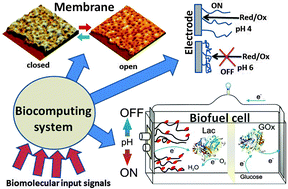
Chem. Commun., 2015,51, 3493-3500
https://doi.org/10.1039/C4CC09851J
Lanthanide luminescent logic gate mimics in soft matter: [H+] and [F−] dual-input device in a polymer gel with potential for selective component release
Non-covalent incorporation of responsive luminescent lanthanide into a polymer gel produces three-output logic circuit with significant naked-eye colour changes.
![Graphical abstract: Lanthanide luminescent logic gate mimics in soft matter: [H+] and [F−] dual-input device in a polymer gel with potential for selective component release](/en/Image/Get?imageInfo.ImageType=GA&imageInfo.ImageIdentifier.ManuscriptID=C5CC05009J&imageInfo.ImageIdentifier.Year=2015)
Chem. Commun., 2015,51, 16565-16568
https://doi.org/10.1039/C5CC05009J
Selective photosensitization through an AND logic response: optimization of the pH and glutathione response of activatable photosensitizers
A molecular AND logic gate, which is an activatable photosensitizer, requires above-threshold values of acidity (pH) and GSH for full activity.
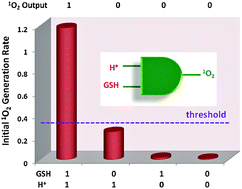
Chem. Commun., 2015,51, 12258-12261
https://doi.org/10.1039/C5CC01261A
H+-Assisted fluorescent differentiation of Cu+ and Cu2+: effect of Al3+-induced acidity on chemical sensing and generation of two novel and independent logic gating pathways
A novel logic gate containing protecting groups interacts with various species (acetonitrile) with fluorescence responses relating to ligand non innocence.
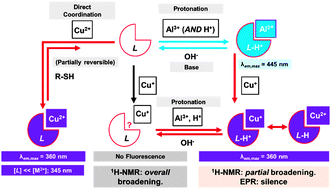
Chem. Commun., 2015,51, 6357-6360
https://doi.org/10.1039/C4CC10025E
Robustness of synthetic circadian clocks to multiple environmental changes
Synthetic network imitating the KaiABC circadian clock from the cyanobacteria S. elongatus was studied in silico and displayed robust behaviour under a wide set of environmental conditions.
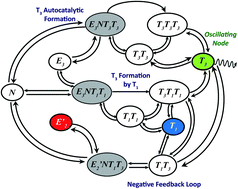
Chem. Commun., 2015,51, 5672-5675
https://doi.org/10.1039/C5CC00098J
Associative chemosensing by fluorescent macrocycle–dye complexes – a versatile enzyme assay platform beyond indicator displacement
Enzymatic reactions of aromatic substrates can be monitored by fluorescence with μM sensitivity in real time by using self-assembled fluorescent receptors.
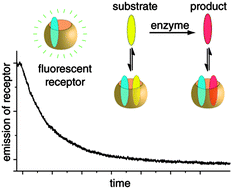
Chem. Commun., 2015,51, 4977-4980
https://doi.org/10.1039/C4CC10227D
A fluorescent bistable [2]rotaxane molecular switch on SiO2 nanoparticles
A fluorescent bistable [2]rotaxane was immobilized onto the surface of SiO2 nanoparticles through click reaction. The shuttling motion of the macrocycle component was driven by external acid–base stimuli both in solution and on SiO2 nanoparticles, accompanied by visual fluorescence changes.
![Graphical abstract: A fluorescent bistable [2]rotaxane molecular switch on SiO2 nanoparticles](/en/Image/Get?imageInfo.ImageType=GA&imageInfo.ImageIdentifier.ManuscriptID=C4CC09976A&imageInfo.ImageIdentifier.Year=2015)
Chem. Commun., 2015,51, 4973-4976
https://doi.org/10.1039/C4CC09976A
Colour-tunable fluorescence of single molecules based on the vibration induced emission of phenazine
Combining the vibration of the phenazine unit (S0) and the intramolecular energy transfer (IET) effect, compound M1–M4 exhibited color-tunable fluorescence even white emission in two different ways.
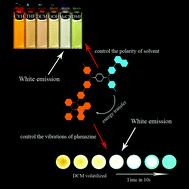
Chem. Commun., 2015,51, 4462-4464
https://doi.org/10.1039/C4CC09613D
pH and light-controlled self-assembly of bistable [c2] daisy chain rotaxanes
Triarylamine – [c2] daisy chain rotaxane conjugates behave as logic-gates controlled by pH and light modulations to self-assemble in supramolecular fibers.
![Graphical abstract: pH and light-controlled self-assembly of bistable [c2] daisy chain rotaxanes](/en/Image/Get?imageInfo.ImageType=GA&imageInfo.ImageIdentifier.ManuscriptID=C4CC10331A&imageInfo.ImageIdentifier.Year=2015)
Chem. Commun., 2015,51, 4212-4215
https://doi.org/10.1039/C4CC10331A
Sweat pore mapping using a fluorescein–polymer composite film for fingerprint analysis
A simple but efficient sweat pore mapping method based on a fluorescein–PVP composite film was developed for fingerprint analysis.
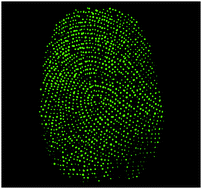
Chem. Commun., 2015,51, 3177-3180
https://doi.org/10.1039/C4CC09085C
Photodriven [2]rotaxane–[2]catenane interconversion
The reversible photocyclomerization of terminal anthracene units enables the interconversion between [2]rotaxane and [2]catenane molecular topologies.
![Graphical abstract: Photodriven [2]rotaxane–[2]catenane interconversion](/en/Image/Get?imageInfo.ImageType=GA&imageInfo.ImageIdentifier.ManuscriptID=C4CC09472G&imageInfo.ImageIdentifier.Year=2015)
Chem. Commun., 2015,51, 2810-2813
https://doi.org/10.1039/C4CC09472G
Aromatic sulfonate anion-induced pseudorotaxanes: environmentally benign synthesis, selectivity, and structural characterization
Aromatic sulfonates allow the effective construction of anion-containing pseudorotaxanes from a tetracationic macrocycle known as the “Texas box” in organic media and under organic-free aqueous conditions.
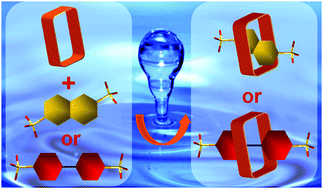
Chem. Commun., 2015,51, 1795-1798
https://doi.org/10.1039/C4CC08284B
A redox-activated fluorescence switch based on a ferrocene–fluorophore–boronic ester conjugate
A novel electrochemically and fluorescence active boronic ester sensor molecule has been developed containing ferrocene and naphthalimide as the redox and fluorophore units.
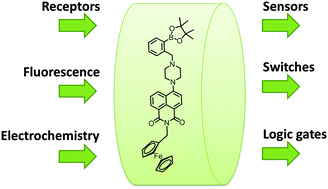
Chem. Commun., 2015,51, 1293-1296
https://doi.org/10.1039/C4CC07891H
A photoswitchable supramolecular complex with release-and-report capabilities
A supramolecular platform with an inherent report function has been designed for photoreversible control of guest concentration in solution.

Chem. Commun., 2015,51, 847-850
https://doi.org/10.1039/C4CC08513B
A dual FRET based fluorescent probe as a multiple logic system
The dual FRET based fluorescent probe showed distinguished responses towards Fe3+ and Hg2+, making it an ideal candidate for multiple logic operations at the molecular level.
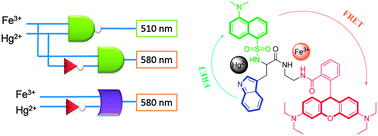
Chem. Commun., 2015,51, 111-113
https://doi.org/10.1039/C4CC08245A
About this collection
Guest edited by he Tian and Alberto Credi, this themed collection demonstrates high-quality research achievements on molecular logic gates and related phenomena. As well as covering molecular logic gates, and more complicated molecular circuits prepared from small molecules, supramolecular systems and biomacromolecules, this collection of Communications and Feature Articles demonstrates the utility of molecular logic into applications in bio-related fields.